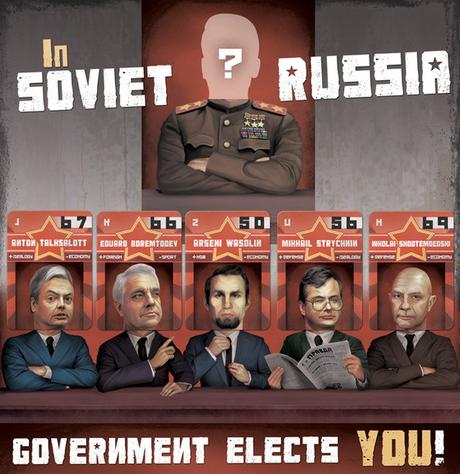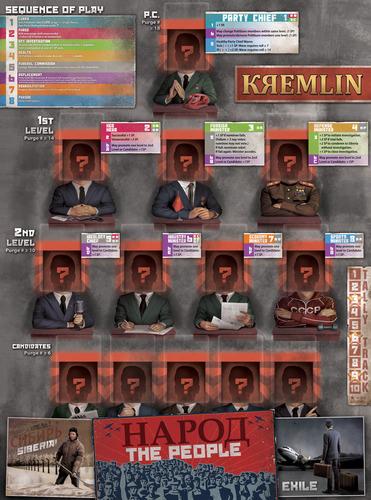In Soviet Russia, politics…well, they’re very entertaining! Also confusing for newcomers, not helped by the awkwardly organised instruction book in the most recent version of the game. If your going into this one new make sure you’ve got an experienced player on hand or you grab one of the fan written sets of instructions from the net.
It goes like this. Each player is a shadowy member of Soviet era Russia politicians. Not a member of the political hierarchy but someone who pulls the strings behind the scenes, playing the system to put the politicians in their pocket in a position of power to serve their own needs. The board depicts a pyramid of political positions with the Party Chief at the top and members of the public at the bottom, with positions like the KGB Head and Foreign Minister arranged in layers of power. Once the politician characters are randomly assigned to roles the players secretly record which ones that have ‘influence’ over, and how many influence points they have on a character. This forms the core mechanic for gameplay, and the most intriguing aspect of the game, as the player who controls the party leader at the end of the game wins.

Gameplay goes over 10 rounds, each round split into different stages. During each round the KGB Head can investigate other politicians and send them to Siberia, the Party Chief can rearrange the hierarchy and if the top position is free there’s a vote to fill it. There’s also a process of aging the characters, with them retiring or potentially dying and removing them from the game. Any votes, investigations, attacks or whatnot get decided by the player who holds the most influence over a given politician. At any time a player can declare their influence over a politician, although if another player declares more influence points than they’ll take control of that role. As you can imagine, picking the right time to reveal an influence, and how much you reveal is integral to the success of the game. It’s not uncommon for the first round or two to go by without anything major happening until the players start revealing their influences but when they do suspicion, betrayal and bargaining become the order of the day.
Being based on a game from the 1980s the flow of the game and unpredictable nature of the layout is pretty polished. Each play through will provide a slightly different experience based on who makes the first move and how closely players hold on to their influence points. For this reason some players might wind up getting on the back foot early in the game and not have the chance to get into a competitive position, which can be frustrating. On the other hand the unique influence mechanic makes the game an intriguing mix of dark humor (as you’d expect when you can use the KGB to bump out the competition) and manipulation. There’s few other games that allow you ally with another player and help control the vote to make their character the party leader only to reveal that you have more secret influence points over them and you take the most powerful position out from under them and ship their other characters off to the gulag so they can’t get revenge. And that’s satisfying.

The new third edition of the game, created through a Kickstarter (and can we get some more 80s games rebooted this way?), features some great artwork and the way the politician cards fit into the spaces on the board is awesome. The original game centred on a group of fictional politicians with wonderfully punny names like Krakenballs and Shootemdedski but this new version has another two sets of characters based on real figures. There’s one set based on historical figures like Stalin and Lenin and one based on modern politicians so yes, you can manipulate Putin. And that is awesome.
We noted earlier that the instructions for the new edition are a bit of a mess, and sadly there’s some other issues. Some games are missing reference cards and dice, although this doesn’t impact on the game, and the board has a misprint covering up some text. It’s sloppy but not a deal breaker.
If you’ve got a good humoured group of players then this is a really fun game. Best not play it with anyone who don’t play well with games involving subterfuge or trickery (you all know one), as being able to claim influence over someone else’s character can make some people spit the dummy or suggest changing the rules, which completely misses the point of the game. If you’ve got an easy going group then this is a lot of fun.

